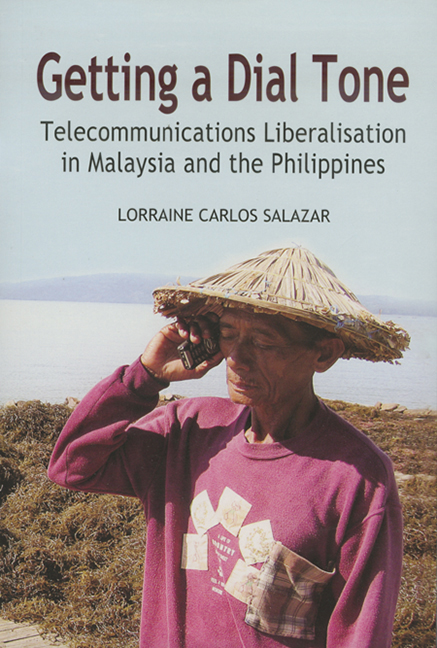Book contents
- Frontmatter
- Dedication
- Contents
- Map of Malaysia and the Philippines
- List of Tables
- List of Figures
- List of Appendices
- List of Abbreviations
- Acknowledgements
- 1 Rent-Seeking, Market Reforms, and States
- 2 Reviewing the Literature: Theories and Puzzles
- 3 Historical Overview of the State and Business in Malaysia and the Philippines
- 4 The Telecommunications Sector in Malaysia and the Philippines Before Reform
- 5 Reforming the Malaysian Telecommunications Sector
- 6 The Liberalisation of Telecommunications in Malaysia
- 7 Regulatory Reforms in Malaysia
- 8 Reforming the Telecommunications Sector of the Philippines
- 9 The New Players and the Service Area Scheme
- 10 Regulatory Reforms in the Philippines
- 11 Conclusions
- Appendices
- Bibliography
- Index
- About the Author
1 - Rent-Seeking, Market Reforms, and States
Published online by Cambridge University Press: 21 October 2015
- Frontmatter
- Dedication
- Contents
- Map of Malaysia and the Philippines
- List of Tables
- List of Figures
- List of Appendices
- List of Abbreviations
- Acknowledgements
- 1 Rent-Seeking, Market Reforms, and States
- 2 Reviewing the Literature: Theories and Puzzles
- 3 Historical Overview of the State and Business in Malaysia and the Philippines
- 4 The Telecommunications Sector in Malaysia and the Philippines Before Reform
- 5 Reforming the Malaysian Telecommunications Sector
- 6 The Liberalisation of Telecommunications in Malaysia
- 7 Regulatory Reforms in Malaysia
- 8 Reforming the Telecommunications Sector of the Philippines
- 9 The New Players and the Service Area Scheme
- 10 Regulatory Reforms in the Philippines
- 11 Conclusions
- Appendices
- Bibliography
- Index
- About the Author
Summary
The puzzle of why the Philippines has failed to develop economically has long been of interest to scholars studying the country and the region. As Paul Hutchcroft has put it, why is the Philippines in a “developmental bog?” The Philippines has widely been considered the exception to the rule or a laggard amidst the so-called economic successes of Southeast Asian newly industrialising countries (NICs). Some have attributed the cause of this problem to a weak state captured by a strong oligarchic class, while others have emphasised the historical impact of neo-colonialism and the Philippines’ continued dependence on the United States. Still others emphasise the Philippines’ poor macroeconomic policies and the country's inward-looking, protected economy.
Against the Philippines — an incessant aspirant to development — stands the contrasting example of Malaysia, a seemingly successful case of rapid economic development. Compared with the weak Philippines state, the Malaysian state is considered strong. This is because it has been consistently able to impose a development policy that seeks to eradicate poverty irrespective of race, and to restructure society by removing the identification of race with economic function. Also, Malaysia has kept an open economy and a tight rein over its macroeconomic policies. While the post-colonial political and social systems in both countries are substantially different, patronage and rent-seeking stand out as clear similarities in Malaysia and the Philippines. Yet, the persistence of patronage and rent-seeking has apparently not prevented growth in Malaysia, whereas it is considered a major explanatory variable for the continued economic underdevelopment of the Philippines.
The 1997 financial crisis that hit Southeast Asian countries brought the economic impact of rent-seeking, cronyism, and corruption to the fore. A considerable number of scholars were unanimous in blaming cronyism and rent-seeking as the root causes of the crisis. Before 1997, cronyism was a term largely used by academics and journalists to describe the Philippines and Indonesia. In fact, cronyism was coined to describe the process whereby Ferdinand Marcos distributed largesse to his family members and close friends.
- Type
- Chapter
- Information
- Getting a Dial ToneTelecommunications Liberalisation in Malaysia and the Philippines, pp. 1 - 17Publisher: ISEAS–Yusof Ishak InstitutePrint publication year: 2007

